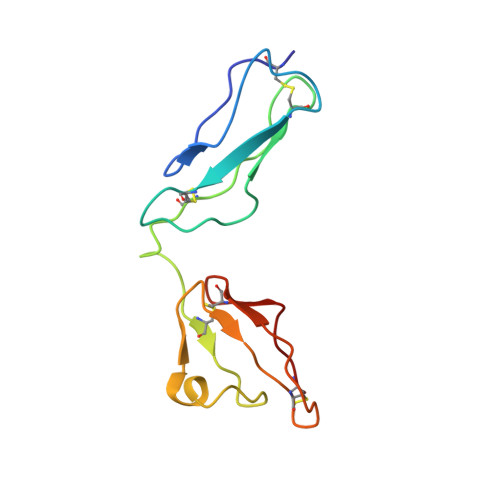The Central Portion of Factor H (Modules 10-15) Is Compact and Contains a Structurally Deviant CCP Module
Schmidt, C.Q., Herbert, A.P., Mertens, H.D.T., Guariento, M., Soares, D.C., Uhrin, D., Rowe, A.J., Svergun, D.I., Barlow, P.N.(2010) J Mol Biol 395: 105-122
- PubMed: 19835885
- DOI: https://doi.org/10.1016/j.jmb.2009.10.010
- Primary Citation of Related Structures:
2KMS - PubMed Abstract:
The first eight and the last two of 20 complement control protein (CCP) modules within complement factor H (fH) encompass binding sites for C3b and polyanionic carbohydrates. These binding sites cooperate self-surface selectively to prevent C3b amplification, thus minimising complement-mediated damage to host. Intervening fH CCPs, apparently devoid of such recognition sites, are proposed to play a structural role. One suggestion is that the generally small CCPs 10-15, connected by longer-than-average linkers, act as a flexible tether between the two functional ends of fH; another is that the long linkers induce a 180 degrees bend in the middle of fH. To test these hypotheses, we determined the NMR-derived structure of fH12-13 consisting of module 12, shown here to have an archetypal CCP structure, and module 13, which is uniquely short and features a laterally protruding helix-like insertion that contributes to a prominent electropositive patch. The unusually long fH12-13 linker is not flexible. It packs between the two CCPs that are not folded back on each other but form a shallow vee shape; analytical ultracentrifugation and X-ray scattering supported this finding. These two techniques additionally indicate that flanking modules (within fH11-14 and fH10-15) are at least as rigid and tilted relative to neighbours as are CCPs 12 and 13 with respect to one another. Tilts between successive modules are not unidirectional; their principal axes trace a zigzag path. In one of two arrangements for CCPs 10-15 that fit well with scattering data, CCP 14 is folded back onto CCP 13. In conclusion, fH10-15 forms neither a flexible tether nor a smooth bend. Rather, it is compact and has embedded within it a CCP module (CCP 13) that appears to be highly specialised given both its deviant structure and its striking surface charge distribution. A passive, purely structural role for this central portion of fH is unlikely.
Organizational Affiliation:
Edinburgh Biomolecular NMR Unit, Centre for Chemical and Translational Biology, Schools of Biological Sciences and Chemistry, University of Edinburgh, Edinburgh EH9 3JJ, UK.














